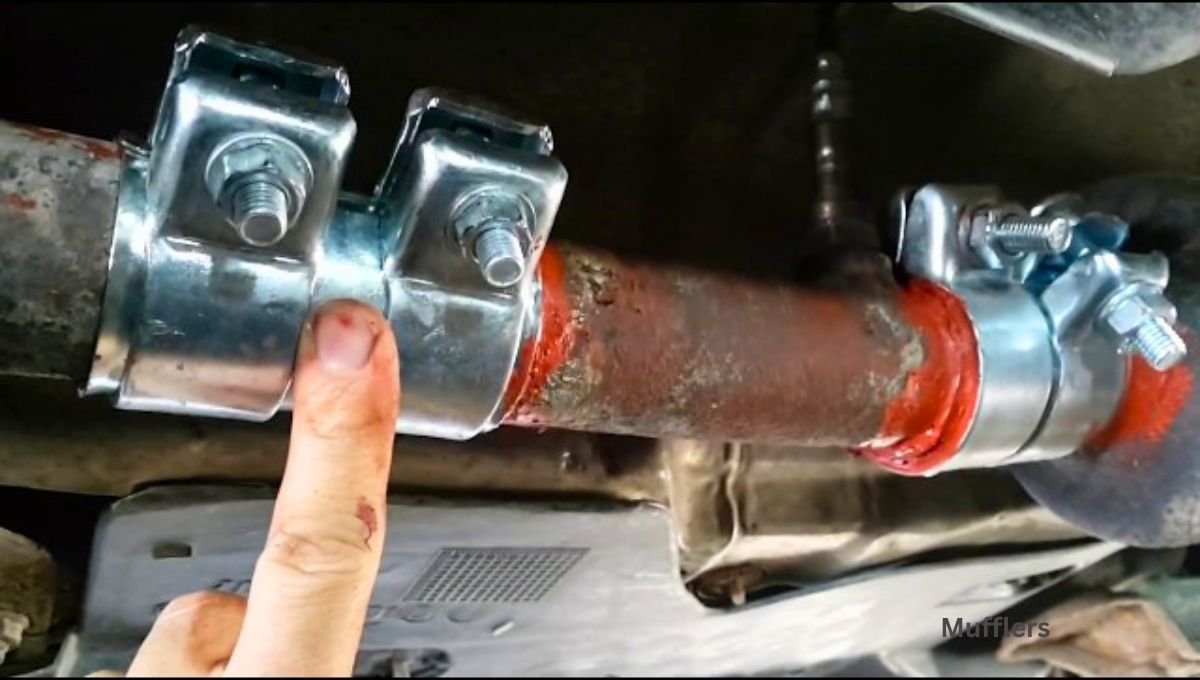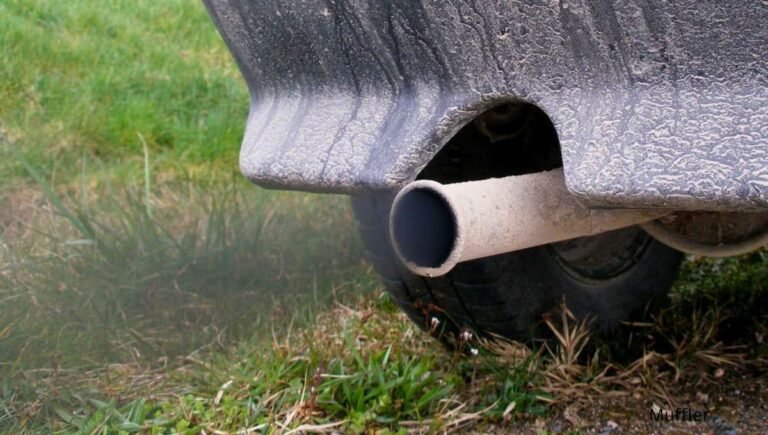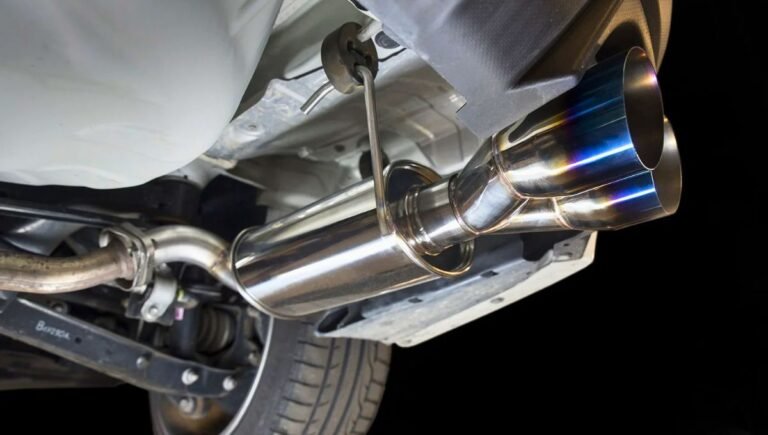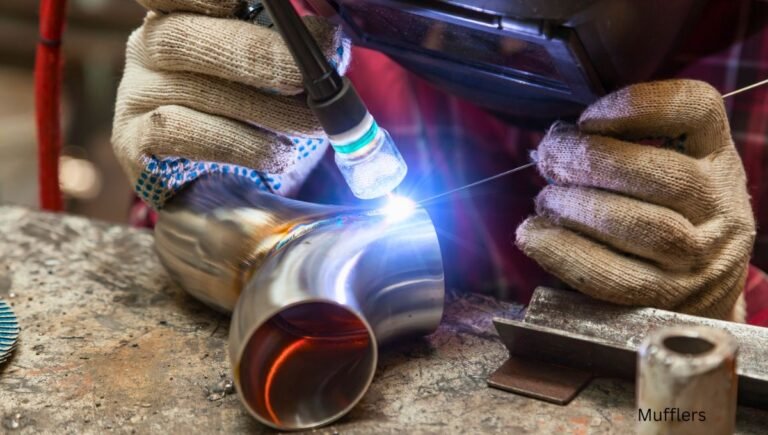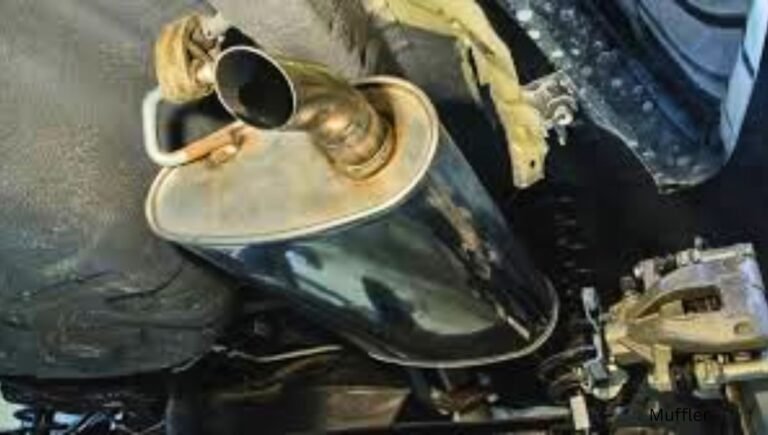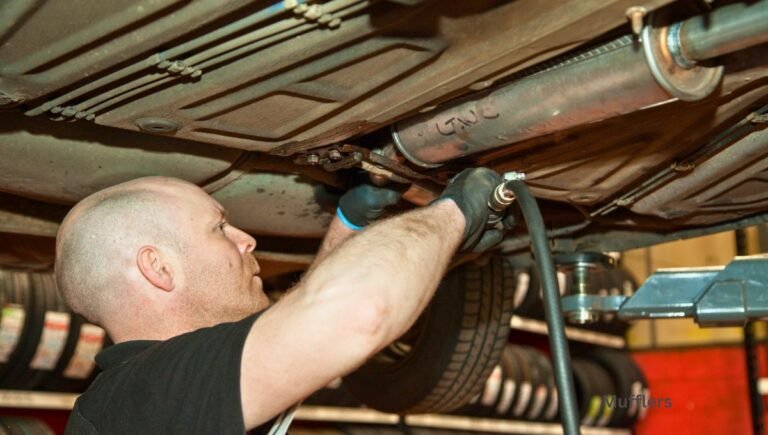How to Attach a Muffler Without Welding? Quick Fix Guide
To attach a muffler without welding, use exhaust clamps and hangers for a secure fit. These parts will keep the muffler in place without the need for welding.
When installing, ensure proper alignment and tightness to prevent any leaks or vibrations. This method provides a convenient and effective way to attach a muffler without the use of welding equipment. By following these steps, you can easily secure your muffler in place and enjoy a well-functioning exhaust system.
Introduction To Muffler Attachment
The Role Of A Muffler
A muffler plays a crucial role in reducing the noise produced by a vehicle’s exhaust system. It also helps to control exhaust emissions and improve engine performance. Proper attachment of the muffler is essential for ensuring its effective functioning.
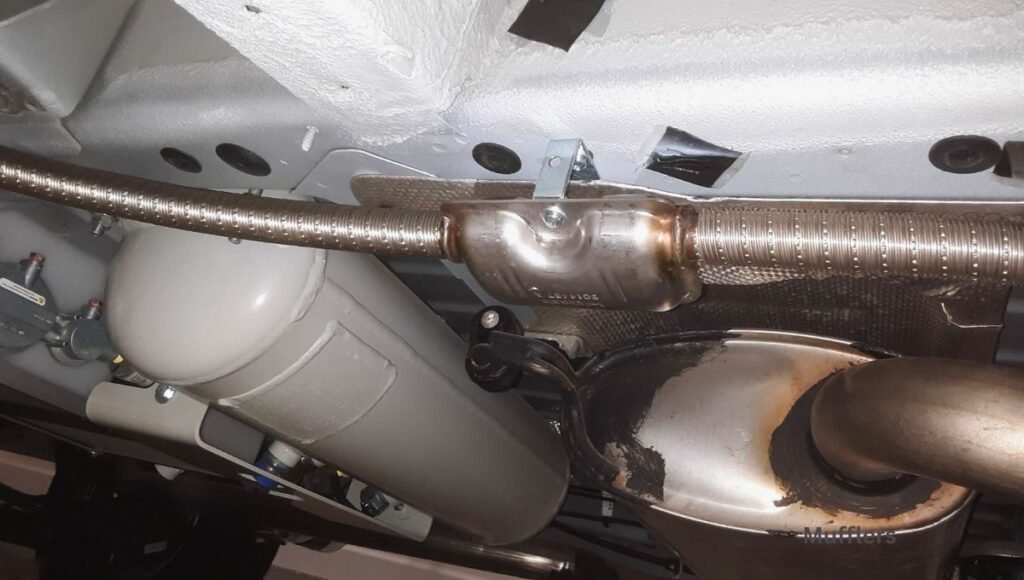
Challenges Of Traditional Welding Methods
Traditional welding methods pose several challenges when it comes to attaching a muffler. These methods often require specialized equipment and expertise, making them inaccessible to many vehicle owners. Additionally, the high heat generated during welding can lead to damage to the surrounding components and may not be suitable for all types of muffler materials.
Tools And Materials Needed
When attaching a muffler without welding, it’s essential to have the right tools and materials on hand. Here’s a breakdown of the key items needed to successfully complete the installation:
Selecting The Right Clamp
When it comes to selecting the right clamp for attaching a muffler, it’s crucial to choose a heavy-duty stainless steel clamp. This type of clamp provides the strength and durability required to securely hold the muffler in place without the need for welding. Look for clamps specifically designed for exhaust systems, as they are engineered to withstand high temperatures and vibrations.
Essential Safety Gear
Before beginning the installation process, it’s important to prioritize safety by wearing essential safety gear. This includes protective gloves to shield your hands from sharp edges and potential debris, as well as safety goggles to safeguard your eyes during the handling of metal components. Additionally, using hearing protection is advisable, especially when working with power tools that generate loud noises.
- Heavy-duty stainless steel clamp
- Protective gloves
- Safety goggles
- Hearing protection
Preparing Your Vehicle
Easily attach a muffler without welding by using exhaust clamps and hangers for a secure fit. Make sure to align the muffler properly and tighten the clamps to prevent any leaks or rattling while driving. This simple DIY method saves time and money on professional welding services.
Securing The Car
Before you start working on your vehicle, it is essential to ensure that it is secured. You can use chocks or blocks to prevent the car from rolling away. Additionally, you should park the car on a flat surface to avoid accidents.
Locating The Muffler Connection
The next step is to locate the muffler connection on your vehicle. You can use the owner’s manual to find the exhaust system’s location and the muffler connection point. Additionally, it would help if you had a wrench to remove the bolts and nuts that hold the muffler.
Attaching The Muffler
Once you have located the muffler connection, you can attach the muffler to the exhaust system. You can use a muffler clamp or a muffler strap to hold the muffler in place. Ensure that you tighten the bolts and nuts securely to prevent the muffler from falling off.
Testing The Connection
After attaching the muffler, you should start the engine and check for any leaks or unusual sounds. If you hear any strange noises or notice any leaks, you should tighten the bolts and nuts further. Additionally, you should check the muffler connection regularly to ensure that it is secure.
In conclusion, preparing your vehicle is an essential step when attaching a muffler without welding. Securing the car, locating the muffler connection, attaching the muffler, and testing the connection are critical steps that you need to follow to ensure that the muffler is securely attached to your vehicle.
Measuring And Cutting
To attach a muffler without welding, start by measuring and cutting the piping to fit the muffler. Ensure a precise fit to avoid any leaks or issues. Use clamps and hangers to secure the muffler in place, providing a sturdy attachment without the need for welding.
When it comes to attaching a muffler without welding, one crucial step in the process is measuring and cutting the necessary components accurately. This ensures a proper fit and alignment, allowing for efficient installation and optimal performance. In this section, we will discuss two key aspects: ensuring accurate alignment and providing tips for clean cutting.
Ensuring Accurate Alignment
Accurate alignment is essential to ensure that the muffler fits perfectly into the exhaust system. Here are a few steps to follow for precise alignment:
- First, position the muffler in the desired location, taking into account any clearance requirements.
- Use a measuring tape to measure the distance between the muffler and the adjoining components, such as the exhaust pipe or catalytic converter.
- Ensure that the measurements are consistent on both sides to maintain symmetry.
- Make adjustments as necessary to achieve the desired alignment.
Remember, proper alignment ensures that the exhaust gases flow smoothly and efficiently through the system, preventing any leaks or performance issues.
Tips For Clean Cutting
Clean cutting is essential to achieve accurate and professional-looking results. Here are some tips to help you achieve clean cuts:
- Use a high-quality hacksaw or reciprocating saw with a fine-toothed blade for precise cutting.
- Apply steady and even pressure while cutting to avoid jagged edges.
- Consider using a miter box or a cutting guide to ensure straight cuts.
- If using a hacksaw, use long, smooth strokes to maintain control and reduce the chances of the blade wandering.
- After cutting, use a file or sandpaper to smooth any rough edges for a clean finish.
By following these tips, you can achieve clean and accurate cuts, allowing for a seamless installation of the muffler without the need for welding.
Remember, measuring and cutting are critical steps in attaching a muffler without welding. By ensuring accurate alignment and employing proper cutting techniques, you can achieve a secure and professional installation. In the next section, we will discuss the different methods you can use to attach the muffler to the exhaust system without welding. Stay tuned!
Attaching The Muffler With Clamps
Attaching a muffler without welding can be a convenient and cost-effective solution for many car enthusiasts. One popular method is using clamps to securely fasten the muffler in place. This step-by-step guide will walk you through the clamping process and provide tips for checking for leaks.
Step-by-step Clamping Process
- Start by gathering all the necessary tools and materials. You will need a muffler clamp kit, which typically includes clamps, bolts, and nuts.
- Position the muffler in the desired location, ensuring it aligns properly with the exhaust system.
- Place the clamps around the muffler, ensuring they are evenly spaced for optimal support.
- Tighten the clamps using a socket wrench or adjustable wrench. Start by hand-tightening the bolts and then use the wrench to secure them further. Be careful not to overtighten, as it can damage the clamps or muffler.
- Double-check the alignment of the muffler and make any necessary adjustments before fully tightening the clamps.
- Once you are satisfied with the placement and alignment, tighten the clamps firmly to ensure a secure attachment.
Checking For Leaks
After attaching the muffler with clamps, it is crucial to check for any potential leaks. Leaks can negatively impact the performance of your vehicle and may result in unwanted noise or vibrations. Follow these steps to check for leaks:
- Start the engine and let it run for a few minutes to warm up.
- Inspect the connection points between the muffler and the exhaust system for any signs of smoke or unusual exhaust emissions.
- Listen for any hissing or popping sounds, as they can indicate a leak.
- Feel around the clamps and joints for any air escaping. You can use a small piece of tissue paper or a damp cloth to detect any air movement.
- If you detect any leaks, loosen the clamps and readjust the muffler’s position. Retighten the clamps and repeat the leak-checking process.
- Once you are confident that there are no leaks, you can enjoy the benefits of your newly attached muffler without welding!
Attaching a muffler without welding using clamps is a simple and effective method that allows for easy installation and removal. With proper clamping and regular leak checks, you can enjoy a well-functioning exhaust system that enhances your driving experience.
Using Exhaust Sealant
Using exhaust sealant is a convenient and effective method for attaching a muffler without welding. This approach eliminates the need for specialized equipment and skills, making it accessible to a wider audience of car enthusiasts and DIYers. By utilizing exhaust sealant, you can securely fasten the muffler in place, ensuring optimal performance and reducing the risk of leaks.

Advantages Of Sealants
Exhaust sealants offer several benefits when it comes to attaching a muffler without welding. They provide a reliable and durable seal, effectively preventing exhaust leaks. Additionally, sealants are resistant to high temperatures, ensuring long-lasting performance. Moreover, they are easy to apply, making the installation process more accessible for individuals without welding experience.
Application Techniques
When using exhaust sealant to attach a muffler, it’s essential to follow proper application techniques. Begin by ensuring that the surfaces are clean and free of debris, allowing the sealant to adhere effectively. Apply the sealant evenly around the joint, creating a tight and secure bond. After the application, allow sufficient time for the sealant to cure, ensuring a strong and reliable connection.
Final Adjustments And Testing
When it comes to final adjustments and testing, it’s crucial to ensure that the muffler is securely attached and functioning optimally.
Adjusting For Optimal Performance
Before road testing, adjust the muffler position for optimal performance. Check for proper alignment and clearance from the body.
Road Testing Your Vehicle
Take your vehicle for a road test to evaluate the muffler’s performance under different driving conditions.
Maintenance Tips
Attach a muffler without welding using these simple maintenance tips. No need for complex techniques or expensive equipment – follow these steps for a quick and easy installation process. Keep your vehicle running smoothly without the hassle of welding.
Regular Inspection Routines
Inspect muffler for rust, cracks, or loose parts monthly.
When To Seek Professional Help
Consult mechanic if excessive damage or complex repairs required.
Alternative Attachment Methods
Attach a muffler without welding using alternative attachment methods. Explore options like clamps, brackets, and hangers to securely fasten the muffler to your vehicle, ensuring a reliable and hassle-free installation process. Say goodbye to the need for welding and enjoy a convenient solution for muffler attachment.
When welding is not an option, there are alternative methods to attach a muffler securely.
Band Clamps And Joint Adaptors
Band clamps and joint adaptors are effective in attaching mufflers without welding.
They provide a strong grip around the muffler and exhaust pipe.
Joint adaptors create a tight seal between the muffler and the exhaust system.
Innovative Solutions On The Market
New solutions like high-temperature adhesive tapes are gaining popularity.
Some innovative products use advanced locking mechanisms for secure attachment.
When choosing an attachment method, consider the muffler material and exhaust system compatibility.
Always follow manufacturer instructions for proper installation to ensure long-lasting attachment.
Conclusion
Attaching a muffler without welding is an excellent alternative for those who don’t have access to welding equipment or don’t want to go through the hassle of welding. With the five methods discussed in this post, you can easily attach your muffler without welding and get back on the road in no time.
Remember to choose the method that works best for your needs and always follow safety precautions. Happy muffler installation!

